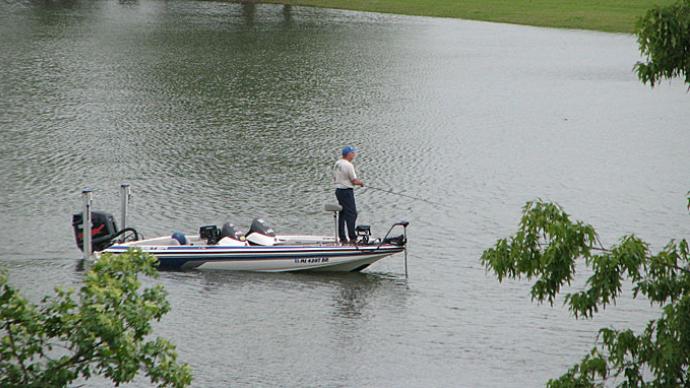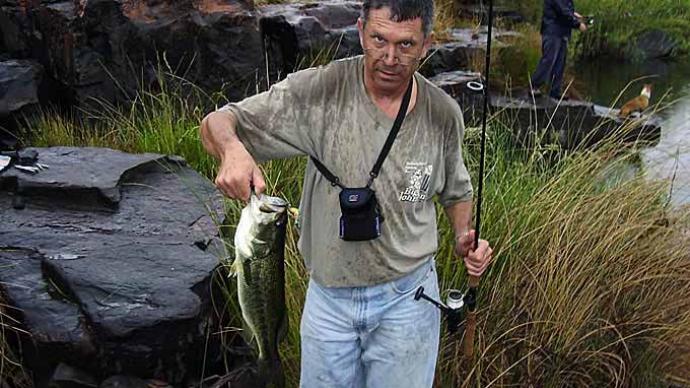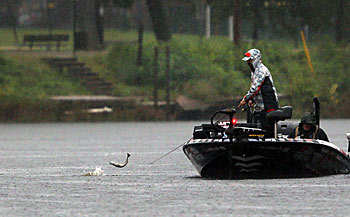
Sleet, snow, rain, heat, or night do not keep mail carriers from delivering the mail. Bass anglers share that dedication. They keep casting when the wind blows waves over the boat’s bow. When the August sun is roasting everything underneath it, they keep casting. And that determination doesn’t wane when clouds open, and rain falls.
Weather changes bass behavior. For example, calm winds and bright sun push them deeper into cover or the water column. Knowing those reactions makes finding them easier because you can anticipate what they will do and how to respond. Rainy days can be uncomfortable if you forget your foul-weather gear. But if you dress appropriately and understand how precipitation affects the water, the bass, and you, they won’t be washouts.
Water
Rain affects lakes, rivers, and reservoirs, regardless if it’s a light mist or heavy downpour. Some changes happen quickly, while others may take a day or so to arrive.
Water temperature, especially in the spring and fall, can change several degrees after rain. How much and what direction depends on the air temperature. For example, cold rains can cause bass enjoying a gentle warm-up in the spring to retreat from their spawning beds. The opposite happens with warm rain.
Rain either falls directly into a body of water or ends up there as runoff through a tributary. The latter increases the current in the main tributary and smaller creeks, activating bass. The increased current pushes bass into predictable locations, such as eddies, where they don’t have to fight the flow. Even storm drains that empty into a lake can attract bass. Rains wash worms and prey from the once dry culverts or gutters, and the new current source attracts curious bass.
Runoff changes water clarity. That won’t happen as soon as rain begins to fall, but as inflows continue at an increased volume, they bring more sediment, which decreases clarity. There is a window where the water is stained but not muddy. That’s when bass are most aggressive. As the rain continues, inflows will run muddy, ruining fishing. Many anglers call creeks at this stage “blown out.” The back of the creeks blow out first, but you can follow the wave of stained water as it moves toward the main lake. Fishing can improve once muddy conditions stabilize because they put bass tighter to cover and thus in more predictable locations. And as tributaries return to normal, clearer water can appear upstream from muddy water.
Rain is rough on rivers because even under calm conditions, they are moving water. Even a small amount can affect the entire system. You can’t escape the increased current unless you head to a creek or backwater that dead ends or turns upstream. If those aren’t options, search for bass close to hard cover, such as rocks, wood, and piers, instead of aquatic grass.
Bass
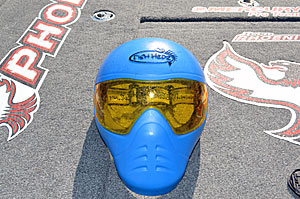
Each bass species behaves differently when it rains. Largemouth love dark, stormy days. They are built for hunting prey in and around thick cover. On the other hand, smallmouth bite better when the sun is shining, illuminating the more or less open water reefs and flats where they cruise for crawfish, minnows, and, in the Great Lakes especially, gobies. That doesn’t mean you should only fish for one or the other when presented with the choice. Largemouth still bite on sunny days and smallmouth on rainy ones. But tweaking your presentations toward one based on current conditions puts the odds of catching slightly more in your favor. And that’s what becoming a better bass angler is about — making the choices, whether it’s lure color, depth, or fish species, that put you in the best situation for catching the most bass.
Fishing can improve just before rain arrives. The air pressure drops, increasing clouds, and the stronger wind stirs the food chain. While bass can feed heavily, strong thunderstorms often shut them down for several hours after a thunderstorm passes through. You may be able to pry some out with slower presentations until things settle down.
The most significant change that rain brings is a low-light condition like you find early or late in the day. That allows the bass to freely roam and stalk prey without being detected as easily as when it is sunny. Low-light conditions are created in three ways. First, clouds block the sun. Second, each raindrop muddles the surface, reducing the amount of light that can pass through. Lastly, there is the wind, which always seems to accompany the rain. The ripples and waves generated cut light penetration, too.
Rainy day bass will chase lures, so show them ones that match their attitude. Big, colorful, and noisy lures are best. Shallow running crankbaits with plenty of rattles, such as square bills, are a good choice. So are spinnerbaits, but make sure at least one blade is a Colorado or an Indiana. The extra thump will help bass find your lure in the low light. Topwaters can be incredibly effective. Rain knocks bugs from the air, and bass, or at least the baitfish they are chasing, feed on those that end up on the water’s surface.
You can cover more water in less time when it rains. Casts do not have to be pinpoint accurate. As you are working down a bank, for example, one cast along a laydown usually is enough to draw out any bass. You also can spread out your casts when covering a flat or weed edge. Bass will find the lure.
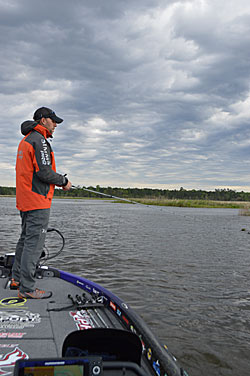
Most slow-moving bottom bouncers, such as jigs and soft plastics, catch bass on dark rainy days. But they don’t allow you to cover water as fast as horizontally retrieved lures such as crankbaits and spinnerbaits. Faster moving versions, such as swim jigs with active trailers and soft jerkbaits like Zoom’s Super Fluke, are exceptions.
Anglers
Weather conditions affect anglers as much as bass. If you’re soaked, you will be cold. That will sap your concentration, letting your mind wander toward steaming bowls of soup and cups of coffee at the lakeside diner instead of what your lure and the bass are doing. So it pays to prepare.
There isn’t a piece of gear that you’ll be more thankful for on a rainy day than a proper rain suit. These suits run the gamut in price, but you do not have to spend a bundle to have one that serves you well. Here are some things you’ll want in the one you purchase.
Look for jackets that have “pit zips,” the zippers that run underneath the sleeves. When open, they reveal a section of mesh that vents the jacket, keeping you cool when it’s hot. Pay attention to the hood’s design. Velcro or cord and stops on the sides and top let you adjust the fit. That means the top of the hood won’t flop in front of your eyes, and the sides won’t block your peripheral vision. Velcro closures around your wrists keep water from running down your arms when you cast or set the hook. Ones around the ankles keep you from walking on the cuffs of your pants. Choose a pair with built-in suspenders so you won’t be pulling them up all day.
If your rain suit is a few years old and losing its water repellency, don’t replace it. First, try one of the wash-in products, such as Nikwax, that can refresh it. You wash the suit in your washing machine and then run it through again, stopping during the soak cycle. That’s when you add the product and let the suit sit for the prescribed amount of time before continuing to the rinse and spin cycles. The exact process can be used on gloves, hats, and other waterproof clothing. And best of all, it doesn’t rob the breathability of fabrics such as Gore-Tex.
Don’t overlook your feet. Flip-flops or sandals are acceptable when it’s warm, but you’ll need a good pair of waterproof boots when it rains. You’ll get more use out of non-insulated boots. Adjust your socks — thinner to thicker — as the weather gets colder.
You’ll want to adjust your sunglasses, too. The gray lenses you depend on when the sun shines hide details under clouds and rain. Wear sunglasses with yellow or amber lenses instead. These colors block out more of the blue light created on overcast days and allow more overall light to pass through than gray lenses. That makes it easier to see. And they protect your eyes the same. Hooks and sinkers move as fast as when the sun isn’t shining.
Protect yourself from stinging rain if you are driving a boat or riding shotgun. Full-faced helmets, such as those used by snowmobilers and motorcycle riders, are gaining popularity with bass anglers. Ski goggles are a time-tested option; spare the bulk that comes with helmets. Facemasks are an in-between choice. Once again, find ones with yellow or amber lenses. They will help you see as you race to the next hot spot.



